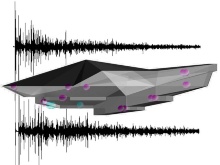Evolutionary Computational Design for Spatial Acoustics
Architectural Form Generation of Acoustic Spaces Employing Evolutionary Design Algorithms Based on Space-morphological and Material Parameters
The design of acoustic spaces, like concert halls or opera houses is, despite all technical means, still a big challenge for both architects and engineers. The present work wants to contribute to the achievement of this challenge. The work investigates fundamentally the possibility of integrating performance based parameter as design drivers into the design process. Since the time of Vitruv, performance of space is a matter of architects’ theoretical and practical work. This work focuses on room acoustics, which takes a more subordinated role in architects’ perception, and promotes it as the exemplary objective of investigation. Performance related design methods have already been manifested in Frei Otto’s soap bubble experiments and the constructions emerging from there. Through the development of computer based methods, simulation and evolution based approaches to support design processes emerged. Simulation based shape optimisation methods in the domain of engineering or shape grammar methods in the domain of architecture witness the development from analogous methods to numerical digital methods, where evolutionary processes are included. With the appearance of computer based methods in science and engineering, since the nineteen sixties, theorists are engaged with the aesthetics linked to digital and serial methods. Not only technical criteria but also aesthetics, which is based on a numerical and serial approach, affects the form generating design system for acoustic spaces. The foundation of the system is the formulation of the acoustic basics and its effect on material and geometry, thus the ‘Raumgestalt’. Aside, the fundamental parts of evolutionary and genetic processes and aesthetic design systems are formulated. The integration to a form generating design system for acoustical spaces is realised by the use of a room acoustic simulation as the main part of an evaluation function within an evolutionary genetic algorithm. Based on a real time room acoustics simulation, a sufficient precise but simpler acoustic simulation is developed. The geometry and the material of the objects are generated on the basis of a genetic code, which is a point list. Absorption and scattering information are assigned correspondingly to the points in the list. The synthesis algorithm is using the points to form tetrahedrons, which emerge to a non-self-intersecting and closed hull. The tetrahedron is a 3-simplex, which represents the simplest 3 dimensional volume existing. Alike the triangle, which has the capacity to approximate any 2 dimensional shapes tetrahedron has the ability to approximate any volumes in any required precision. This method assures that the surface of the object is continuously closed and therefore allows executing a room acoustic simulation. Besides the hull, the source receiver constellation is also a crucial part of the acoustic system. It is defined by the user as a spatial configuration and is used in the simulation. The described design process is not universal but has to be defined for each design task individually. Therefore both, the evolutionary as well as the evaluation algorithm is providing different settings and weighting settings to allow investigative explore. Thus users retain their responsibility for individual design tasks. The results of the shape generating algorithm are representing fundamental concepts for potential acoustic spaces rather than finalised architecture. This becomes obvious through the comparison of different ‘Gestalten’ created by the algorithm and corresponding acoustic building types. The shape generation algorithm using the corresponding source receiver constellation deduced from the building precedent creates alternative spatial concepts with at least the same acoustic quality as the precedent. The presented work shows that the developed shape generation method works in principle. The generated results show potential for improvement in respect to architectural and aesthetical quality. Further potential is also discovered through the extension of the considered performance criteria towards climatic or other criteria which can be represented by numerical simulations.
Link to the PDF of the dissertation on OPUS: http://dx.doi.org/10.18419/opus-109
ICD Institute for Computational Design and Construction - Prof. Achim Menges
Institute of Building Materials, Building Physics, Building Technology – Prof. H. Ertel
casinoLab Laboratory for Spatial Acoustics Simulation
Scientific Development
Benjamin Achim Spaeth
Research Assistants
Alexander Fries
Selected Publications
Spaeth, B. and Menges, A.: 2011, Performative Design for Spatial Acoustics – Concept for an evolutionary design algorithm based on acoustics as design driver, Proceedings of the 29th eCAADE Conference, Ljubljana 21-24 September 2011, pp. 461-468. (ISBN 978-9491207013)


